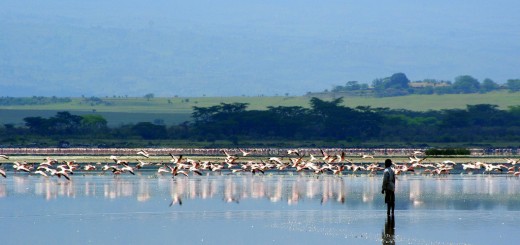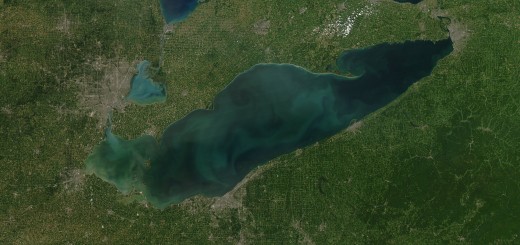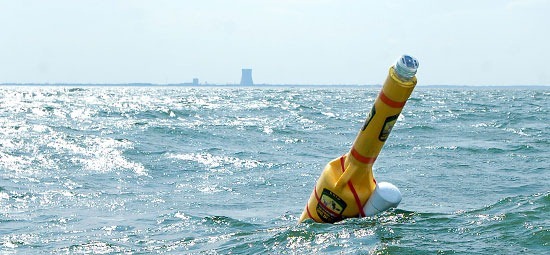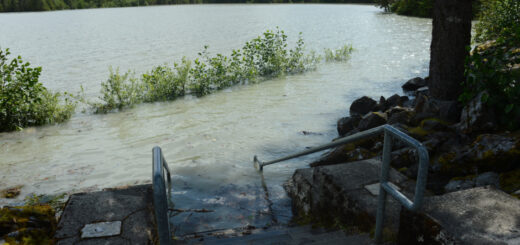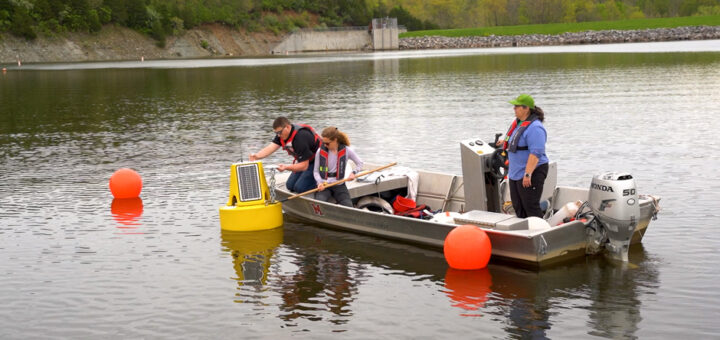Research Brief: Evaluating Wave Energy Availability in the Great Lakes and Blue Economy Opportunities
0As part of the larger Powering the Blue Economy (PBE) initiative started by the Department of Energy, coastal researchers in fresh and saltwater environments are turning their attention toward harnessing wave energy through converters integrated into existing and new open-water platforms.
The PBE focuses on marine energy and resources, and despite the large waves that can be produced in the Great Lakes during storm events, the US Marine Energy Atlas does not quantify the Great Lakes’ wave energy resource.1-3
To fill this information gap, a 2024 study published in Renewable Energy analyzed historical wave model data and NDBC buoy observations from 2006 to 2020 in the Laurentian Great Lakes to evaluate wave energy potential in the region.4
The Great Lakes, in particular, provide a unique opportunity to develop and test novel wave energy converter (WEC) technology in a freshwater setting. While less energetic than the oceans, sea states across the Great Lakes often provide wave conditions attractive to early-stage WECs.
Furthermore, previous literature suggests that wave conditions in the Great Lakes share some similarities with those observed at times in the Arctic. As sea ice extent decreases and open water becomes more prevalent, this region is also being considered for wave energy harvesting in a range of applications.5
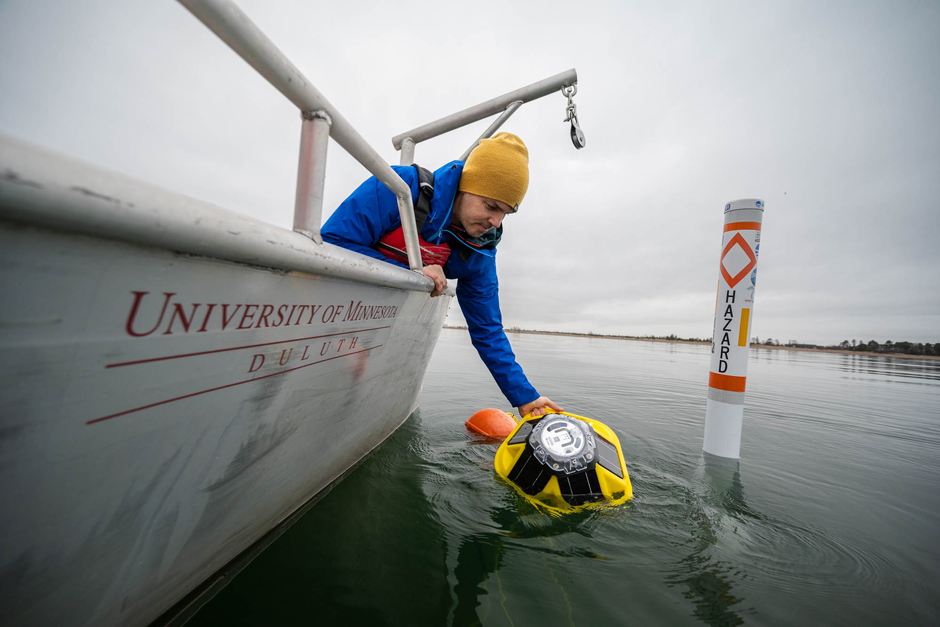
Craig Hill places the Spotter Buoy into Lake Superior near Park Point Beach in Duluth, MN. (Credit: UMN Duluth PR Office)
Methods
The study notes the importance of meeting International Electrotechnical Commission (IEC) standards for the assessment of wave energy resources (reconnaissance, feasibility, and design).6 The resulting estimation uncertainty ranges from high to low.4
Each of the standards have “requirements for spatial and temporal resolution, boundary conditions, wind field and bathymetry inputs, and physical processes incorporated in the model.”4
The wave model data used in this study were derived from the Great Lakes Environmental Research Lab’s Donelan wave model (now retired and transitioned to higher resolution WaveWatch III models). The Donelan model involves a grid-based approach to estimating wave conditions on the lakes.7
This model was selected due to limited wave datasets from existing databases, particularly because many of the wave measurement systems on the lakes—for example, data buoys—are removed during the winter, leaving data gaps. Therefore, the model is necessary to fill spatiotemporal gaps in measurements.
In order to analyze monthly statistical wave power distribution throughout the Great Lakes, nine data buoys were selected to compare wave power between lakes with differing physical characteristics.
Deep-water omnidirectional wave power results were categorized based on the US wave energy classification scheme:
- Class I (Excellent)
- Class II (Good)
- Class III (Marginal)
- Class IV (Poor)
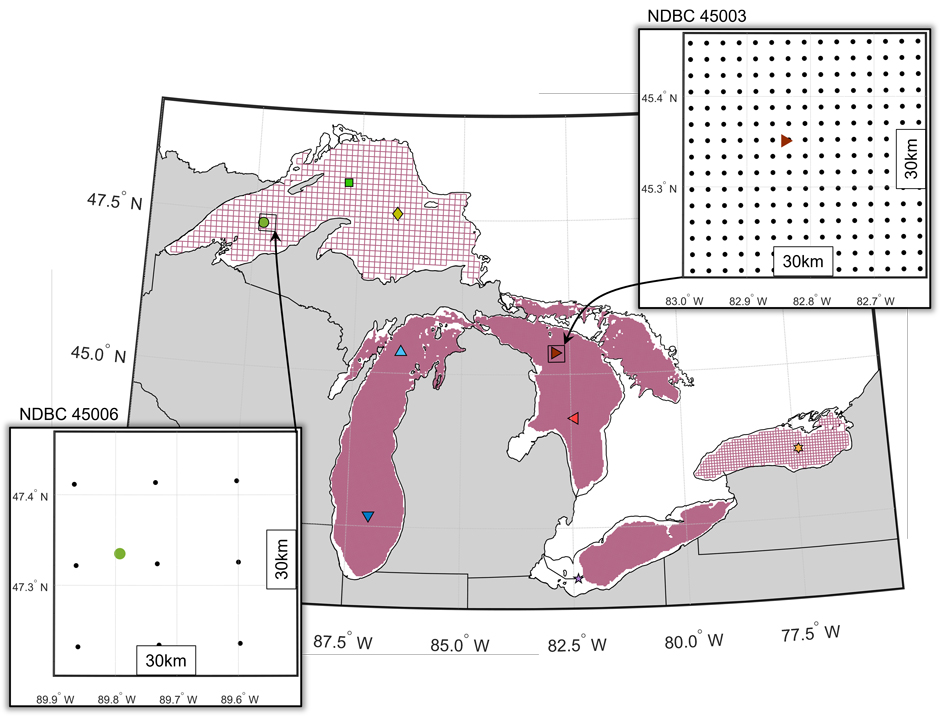
Figure 1. Representation of the Donelan wave model computational grids implemented on the Great Lakes. White areas within the lakes represent areas where the water depth is less than 16 m, per IEC guidelines. Zoomed-in plots show the model grid points as black dots. Colored symbols represent locations of Great Lakes NDBC buoys: Buoy 45006 (lime green circle), Buoy 45001 (green square), Buoy 45004 (yellow diamond), Buoy 45002 (light blue upright triangle), Buoy 45007 (dark blue upside-down triangle), Buoy 45003 (dark red triangle pointing to the right), Buoy 45008 (coral triangle pointing to the left), Buoy 45005 (purple five-pointed star), Buoy 45012 (yellow six-pointed star). (Pheifer and HIll, 2025)
Results
The Donelan model falls short on the IEC standards for reconnaissance assessment because it does not meet the requirements to directly model wave whitecapping, wave reflections, wave-current interactions, and various other non-linear wave characteristics.4,6 Still, the study yields provisional data to guide future research on wave energy in the Great Lakes.
Wave power is highest across the Great Lakes between October and February, while May through August contains particularly low wave power availability.
The average deep water omnidirectional wave power between 2006 and 2020 “indicates that 88% of the grid points included in the study […] for Lakes Erie, Michigan, Ontario, and Superior, and 71 % of Lake Huron fall into Toal Power Class III (Marginal), with the rest of the Great Lakes surface area falling into Class IV.”4
Results also indicated that the Great Lakes generally experience high-frequency waves, which only 21 % of the coastal US experience.4
Overall, the Great Lakes experience frequent and marginal waves in a freshwater setting, making it the ideal scaled field laboratory for the design, testing, and long-term deployment of small-scale wave energy converters that target PBE initiatives or other emerging marine industries.
Craig Hill, one of the study’s authors, also emphasizes that the study highlights a growing need to quantify the nearshore environment across the Great Lakes using higher-resolution numerical models and more observations.
He explains, “This is the work that we’re continuing to pursue, especially as we’re seeing more open water seasons during the winter across the Great lakes.”
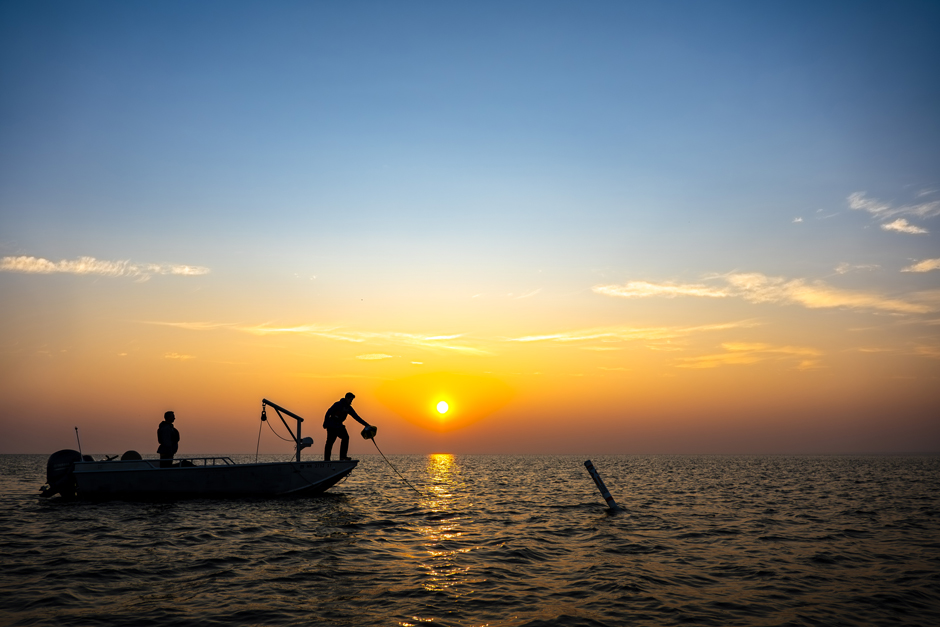
A Spotter Buoy and Smart Mooring are deployed at sunrise on Lake Superior near Park Point Beach in Duluth, MN. Data from the buoy informs beachgoers about wave conditions and water temperatures, while also assisting the local NWS office in determining rip current risk levels along Park Point Beach. (Credit: UMN Duluth PR Office)
Ongoing Work
Craig Hill’s research group at the University of Minnesota (UMN) Duluth is moving forward with other projects, building off this initial wave energy assessment of the Great Lakes.
The group is looking to employ higher resolution WaveWatch III modeling to improve wave energy assessments in nearshore environments on the Great Lakes, designing and performing scaled model tank tests of new, novel coastal infrastructure integrated WECs, and exploring how WECs may operate in environments where floating sea ice or other debris may be present, such as in the Arctic.
These initiatives move the group at UMN Duluth closer to the goal of someday testing WECs on Lake Superior with a vision for using the Great Lakes as a development environment for technologies that have applications across the globe.
In addition to researching wave energy in the Great Lakes, Hill’s lab is working to spread the word about this work. Current graduate student Gracie Bahr is presenting on this research and ongoing studies related to this topic at the International Association for Hydro-Environment Engineering and Research (IAHR) Conference.
Other similar initiatives are also being pursued in other parts of the Great Lakes, including the University of Michigan’s small wave energy project in collaboration with a community on Beaver Island in northern Lake Michigan, among other marine energy and PBE initiatives.
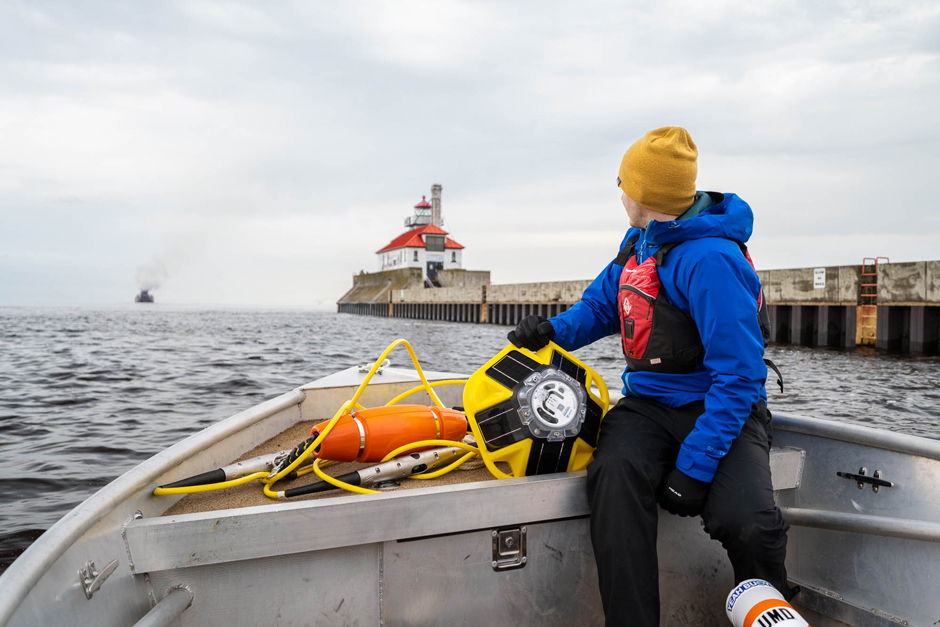
Craig Hill, Associate Professor in Mechanical Engineering at the University of Minnesota Duluth, heads out onto Lake Superior through the Duluth entry to deploy a Spotter Buoy. Observations help inform nearshore wave characteristics and wave energy availability near Duluth, MN. (Credit: UMN Duluth PR Office)
Sources
- Powering the Blue Economy, Exploring Opportunities for Marine Renewable Energy in Maritime Markets, 2022.
- S. Ahn, K.A. Haas, V.S. Neary, Wave energy resource classification system for US coastal waters, Renew. Sustain. Energy Rev. 104 (2019) 54–68, https://doi.org/10.1016/j.rser.2019.01.017.
- Marine Energy Atlas. National Renewable Energy Lab n.d. https://maps.nrel.gov/ marine-energy-atlas (accessed August 15, 2023).
- Pheifer, C., & Hill, C. (2024). Great Lakes wave energy resource classification and Blue Economy opportunities. Renewable Energy, 235, 121213. https://doi.org/10.1016/j.renene.2024.121213
- K. Christakos, G. Lavidas, Z. Gao, J.-V. Bjorkqvist, ¨ Long-term assessment of wave conditions and wave energy resource in the Arctic Ocean, Renew. Energy, 220 (2024) 119678, https://doi.org/10.1016/j.renene.2023.119678.
- Marine energy: wave, tidal and other water current converters, in: Part 101, Wave Energy Resource Assessment and Characterization Part 101, International Electrotechnical Commission, Geneva, Switzerland, 2015, Edition 1.0.
- Donelan, M. A., Curcic, M., Chen, S. S., & Magnusson, A. K. (2012). Modeling waves and wind stress. Journal of Geophysical Research: Oceans, 117(C11). https://doi.org/10.1029/2011JC007787




